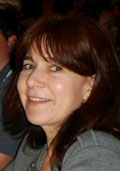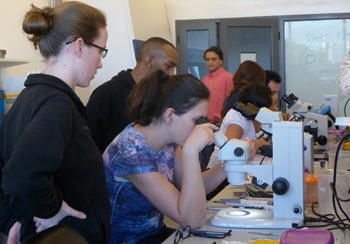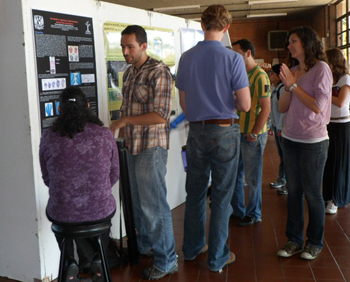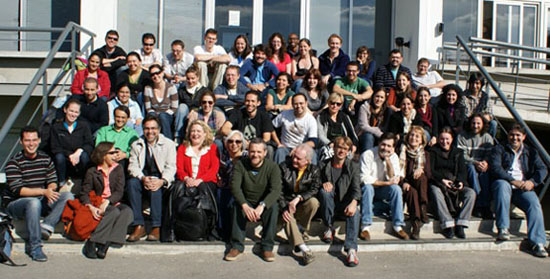SDB-LASDB 2012 PASI Short
Course Report
By Jennifer Fish
 Jennifer Fish is a postdoc in the Department of Orthopaedic Surgery at the University of California, San Francisco
in
Richard Schneider's lab. She studies craniofacial development,
in particular the jaw, with a focus on the role of variation in development, disease, and evolution. Jennifer was one of thirty students selected from a pool of 77 applicants from the United States and nine Latin American countries to attend the SDB-LASDB PASI short course. Jennifer Fish is a postdoc in the Department of Orthopaedic Surgery at the University of California, San Francisco
in
Richard Schneider's lab. She studies craniofacial development,
in particular the jaw, with a focus on the role of variation in development, disease, and evolution. Jennifer was one of thirty students selected from a pool of 77 applicants from the United States and nine Latin American countries to attend the SDB-LASDB PASI short course.
The
Satellite Short
Course of the Sixth International Meeting of the
Latin American Society for Developmental Biology was
held at the Universidad de la Republica &
Institut
Pasteur de Montevideo in Montevideo, Uruguay from
April 16-25, 2012. The 2012 course, A Systems
Biology Approach to Understanding Mechanisms of Organismal Evolution, offered a combination of
lectures with significant hands-on learning of
important theories, concepts, and methods in
evolutionary biology. Scientists at all levels of
their careers came from around the world to
participate in this course with instructors
representing Argentina (Rolando Rivera Pomar),
England (Andrea Streit and
Claudio Stern), Germany (Detlev
Arendt), Switzerland (Brigitte Galliot), the United
States (Siobhan Brady,
Yolanda Cruz,
Katia Del Rio-Tsonis,
Nipam Patel,
Alejandro Sanchez-Alvarado,
Billie Swalla, and
Panagiotis Tsonis), local scientists
Luis Acerenza,
Nibia Berois,
Maria Castello,
Enrique Lessa, and
Flavio Zolessi from Uruguay, and 30
students from 29 universities in 7 different
countries throughout the American continents.
 The aim of the 2012 short course was to teach
young scientists novel methodological techniques in
evolutionary biology and introduce them to a variety
of model organisms in order to expand their
knowledge base of evolutionary processes. Emerging
approaches to investigating systems biology and gene
regulatory networks were a particular emphasis of
this year's course. Multiple bioinformatic tools,
including Biotapestry,
Cytoscape, and
CellNetAnalyzer, were taught in hands-on computer
based modules. A focus of these modules was to
integrate data from disparate sources to allow the
investigator to generate testable hypotheses about
biological processes. For example, in the Cytoscape
lesson, we generated a gene regulatory network using
published data of gene targets of the well-studied
Drosophila Hox genes,
Ultrabithorax and
homothorax
derived from ChIP analyses. Our Cytoscape-generated
networks allowed us to predict the tissue-specific
expression of
spalt, a downstream target of Hox
genes in this network. We subsequently tested
hypotheses based on these bioinformatic predictions
by investigating spalt expression in the Arthropod
lab module. The aim of the 2012 short course was to teach
young scientists novel methodological techniques in
evolutionary biology and introduce them to a variety
of model organisms in order to expand their
knowledge base of evolutionary processes. Emerging
approaches to investigating systems biology and gene
regulatory networks were a particular emphasis of
this year's course. Multiple bioinformatic tools,
including Biotapestry,
Cytoscape, and
CellNetAnalyzer, were taught in hands-on computer
based modules. A focus of these modules was to
integrate data from disparate sources to allow the
investigator to generate testable hypotheses about
biological processes. For example, in the Cytoscape
lesson, we generated a gene regulatory network using
published data of gene targets of the well-studied
Drosophila Hox genes,
Ultrabithorax and
homothorax
derived from ChIP analyses. Our Cytoscape-generated
networks allowed us to predict the tissue-specific
expression of
spalt, a downstream target of Hox
genes in this network. We subsequently tested
hypotheses based on these bioinformatic predictions
by investigating spalt expression in the Arthropod
lab module.
The course also contained modules in standard
developmental biological techniques, such as
comparative development and morphology. A focus was
placed on exposure to non-model systems, such as
annual and electric fish, as well as multiple
invertebrate species. There were several modules on
molecular mechanisms of tissue regeneration, in
which we investigated animals of differing levels of
complexity and cuteness (planaria, hydra, and
axolotl). In addition to comparative analyses, the
wet lab modules covered many classical methods in
gene expression and embryonic manipulation,
including tissue transplantation and electroporation
in chick embryos.
 Beyond the lessons in the classroom, two important
messages were re-enforced to me, as a participant in
this course. First, although funding issues
influence scientific progress in many ways,
creativity and resourcefulness cannot be
underestimated. In this regard, I was consistently
impressed with the persistence and ingenuity of the
local scientists to find solutions to technical
challenges and devise alternative strategies to
answer their scientific questions of interest.
Second, science is a global discipline, undertaken
by people of different backgrounds, cultures and
worldviews.
Yet the ethic of science, built around
the pursuit of knowledge towards a greater
understanding of the natural world, can be a
unifying force across many boundaries. As we are all
well aware, this does not mean scientists, or even
participants in this course, always agree on
everything. We are all chordates, but we still
debate the origin of the first neuron ancestral to
our dorsal nerve cord. Nonetheless, at the heart of
this and other scientific debates is a common goal
to understand the unknown. To accomplish this goal,
open communication and exchange of knowledge is
essential, and the 2012 LASDB mini-course provided
an environment where the best aspects of the
scientific community were manifested. Beyond the lessons in the classroom, two important
messages were re-enforced to me, as a participant in
this course. First, although funding issues
influence scientific progress in many ways,
creativity and resourcefulness cannot be
underestimated. In this regard, I was consistently
impressed with the persistence and ingenuity of the
local scientists to find solutions to technical
challenges and devise alternative strategies to
answer their scientific questions of interest.
Second, science is a global discipline, undertaken
by people of different backgrounds, cultures and
worldviews.
Yet the ethic of science, built around
the pursuit of knowledge towards a greater
understanding of the natural world, can be a
unifying force across many boundaries. As we are all
well aware, this does not mean scientists, or even
participants in this course, always agree on
everything. We are all chordates, but we still
debate the origin of the first neuron ancestral to
our dorsal nerve cord. Nonetheless, at the heart of
this and other scientific debates is a common goal
to understand the unknown. To accomplish this goal,
open communication and exchange of knowledge is
essential, and the 2012 LASDB mini-course provided
an environment where the best aspects of the
scientific community were manifested.
The course was structured so that students and
faculty had concentrated research blocks spent
together in a closed environment. Despite the long
days and often rigorous schedule, the setting and
atmosphere established by the course organizers
encouraged all participants to interact equally,
with no sense of hierarchy, creating a comfortable,
amicable environment where students could freely ask
questions about all aspects of science- from
methods, to publishing strategies, to advice on
post-doctoral applications. Impromptu discussions
and spontaneous chalkboard explanations were
commonly seen throughout the 10-day course. We
worked together, ate together, and (sometimes)
danced together. In the end, the 2012 course
achieved its goal to be integrative, both
methodologically, by combining techniques to answer
biological questions, and personally, in building
lasting relationships. For this unique experience,
all the participants sincerely thank the organizers,
Mike Levine (University of California, Berkeley),
Ida Chow (Society for Developmental Biology), Flavio
Zolessi (Universidad de la Republica, and Nibia
Berois (Universidad de la Republica), as well as the
local volunteers who made the 2012 LASDB mini-course
possible.
|
 |
|
2012 SDB-LASDB PASI Short Course students and faculty |
|